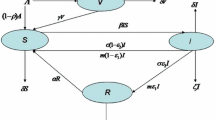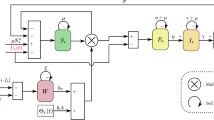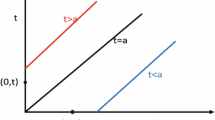Abstract
In this paper, we have proposed and formulated an epidemic model with two types of diseases-one is comparative weaker and the other is comparatively stronger with the assumption that both the diseases are active simultaneously in the system. The dynamical behavior of the model; equilibrium analyses with their existence criteria and local stability criteria have been discussed rigorously. With the help of second generation matrix method, we evaluate basic reproduction number of the proposed model. We propose an optimal control problem considering treatment as control parameter and solve it in order to minimize the compound loss due to the presence of infection. All the theoretical results are verified with some appropriate computer simulation works.












Similar content being viewed by others
References
Kermack, W.O., Mckendric, A.G.: Contribution to the mathematical theory of epidemics. Proc. R. Soc. Lond. Ser. A 115, 700–721 (1927)
Andreasen, V., Lin, J., Levin, S.A.: The dynamics of cocirculating influenza strains conferring partial crossimmunity. J. Math. Biol. 35, 825–842 (1997)
Hethcote, H.W.: The mathematics of infectious diseases. SIAM Rev. 42, 599–653 (2000)
Driessche, P.V., Watmough, J.: Reproduction numbers and sub-threshold endemic equilibria for compartmental models of disease transmission. Math. Biosci. 180, 29–48 (2002)
Makinde, O.D., Okosun, K.O.: Impact of chemo-therapy on optimal control of malaria disease with infected immigrants. Biosystems 104, 32–41 (2011)
Kar, T.K., Jana, S.: Application of three controls optimally in a vector-borne disease a mathematical study. Commun. Nonlinear Sci. Numer. Simulat. 18, 2868–2884 (2013)
Okosun, K.O., Makinde, O.D., Takaidza, I.: Impact of optimal control on the treatment of HIV/AIDS and screening of unware infectives. Appl. Math. Model. 37, 3802–3820 (2013)
Hugo, A., Makinde, O.D., Kumar, S., Chibwana, F.F.: Optimal control and cost effectiveness analysis for newcastle disease eco-epidemiological model in Tanzania. J. Biol. Dyn. 258, 19–32 (2014)
LaSalle, J.P.: The Stability of Dynamical Systems. SIAM, Philadephia (1976)
Guckenheimer, G., Holmes, P.: Nonlinear Oscillations, Dynamical Systems, and Bifurcations of Vector Fields. Springer, New York (1983)
Rahaman, M.A., Zou, X.: Flu epidemics; a two-strain flu model with a single vaccination. J. Biol. Dyn. 5(5), 376–390 (2011)
World Health Organization (2010). http://www.who.int/csr/don/2010_04_09/en/index.html. Accessed 9 Apr 2010
Nishiro, H., Iwata, K.: A simple mathematical approach to deciding the dosage of vaccine against pandemic H1N1 influenza. Euro Surveill. 14, 57–60 (2009)
Kooi, B.W., Aguiar, M., Stollenwerk, N.: Analysis of an asymmetric two-strain dengue model. Math. Biosci. 248, 128–139 (2014)
Nucci, M.C., Leach, P.G.L.: Lie integrable cases of the simplified multistrain/two-stream model for tuberculosis and dengue fever. J. Math. Anal. Appl. 333, 430–449 (2007)
Rahman, S.M.A., Zou, X.: Global dynamics of a two-strain disease model with latency and saturating incidence rate. Can. Appl. Math. Q. 20, 51–73 (2012)
Meng, X., Zhao, S., Feng, T., Zhang, T.: Dynamics of a novel nonlinear stochastic SIS epidemic model with double epidemic hypothesis. J. Math. Anal. Appl. 433, 227–242 (2016)
Meng, X.Z., Li, Z.Q., Wang, X.L.: Dynamics of a novel nonlinear SIR model with double epidemic hypothesis and impulsive effects. Nonlinear Dyn. 59, 503–513 (2010)
Eckalbar, J.C., Eckalbar, W.L.: Dynamics of an epidemic model with quadratic treatment. Nonlinear Anal. Real World Appl. 12(1), 320–332 (2011)
Okosun, K.O., Ouifki, R., Marcus, N.: Optimal control analysis of a malaria disease transmission model that includes treatment and vaccination with waning immunity. Biosystems 106, 136–145 (2011)
Jana, S., Nandi, S.K., Kar, T.K.: Complex dynamics of an SIR epidemic model with saturated incidence rate and treatment. Acta Biotheor. 64, 65–84 (2016)
Okosun, K.O., Makinde, O.D.: A co-infection model of malaria and cholera diseases with optimal control. Math. Biosci. 258, 19–32 (2014)
Tilahun, G.T., Makinde, O.D., Malonza, D.: C-dynamics of Pnumonia and Typhoid fever disease with cost-effective optimal control analysis. Appl. Math. Comput. 316, 438–459 (2017)
Zhang, F.-F., Jin, Z., Sun, G.-Q.: Bifurcation analysis of a delayed epidemic model. Appl. Math. Comput. 216, 753–767 (2010)
Cai, L., Guo, S., Ghosh, M.: Global dynamic of a dengue epidemic mathematical model. Chaos Solitons Fractals 42, 2297–2304 (2009)
Kar, T.K., Mandal, P.K.: Global dynmics and bifurcation in delayed SIR epidemic model. Nonlinear Anal. Real World Appl. 12(4), 2058–2068 (2011)
Birkoff, G., Rota, G.C.: Ordinary Differential Equations. Ginn, Boston (1982)
Diekmann, O., Heesterbeek, J.A.P.: Mathematical Epidemiology of Infectious Diseases, Model Building, Analysis and Interpretation. Wiley, Chichester (2000)
Chitnis, N., Hyman, J.M., Cushing, J.M.: Determining important parameters in the spread of malaria through the sensitivity analysis of a mathematical model. Bull. Math. Biol. 70(5), 1272–1296 (2008)
Jung, E., Lenhart, S., Feng, Z.: Optimal control of treatments in a two-strain tuberculosis model. Discrete Contin. Dyn. Syst. Ser. B 2–4, 473–482 (2002)
Joshi, H.R.: Optimal control of an HIV immunology model. Optim. Control Appl. Methods 23, 199–213 (2002)
Zaman, G., Kang, Y.H., Jung, I.H.: Stability analysis and optimal vaccination of an SIR epidemic model. BioSystems 93, 240–249 (2008)
Pontryagin, L.S., Boltyanskii, V.G., Gamkrelidze, R.V., Mishchenko, E.F.: The Mathematical Theory of Optimal Processes. Wiley, New York (1962)
Lukes, D.L.: Differential Equations: Classical to Controlled. Academic Press, New York (1982)
Lenhart, S., Workman, J.T.: Optimal Control Applied to Biological Models. Mathematical and Computational Biology Series. Chapman & Hall/CRC, Boca Raton (2007)
Acknowledgements
Research of T. K. Kar is financially supported by the Council of Scientific and Industrial Research (CSIR), Government of India (File No. 25(0224)/13/EMR-11. Dated: 05/09/2013). Further the authors would like to acknowledge the anonymous reviewers and Dr. Santanu Saha Ray, Editor in Chief of the journal for their comments and suggestions and comments regarding the improvement of the quality of the manuscript.
Author information
Authors and Affiliations
Corresponding author
Additional information
Publisher's Note
Springer Nature remains neutral with regard to jurisdictional claims in published maps and institutional affiliations.
Appendix A
Appendix A
The characteristic equation of the system (1) at the unique endemic equilibrium \(E^*\) is given by:
where, \(N_1=-A_1-B_2-C_3-D_4\), \(N_2=-A_2 B_1+A_1 B_2-A_3 C_1+A_1 C_3+A_1 D_4-B_3 C_2+B_2 C_3+B_2 D_4+C_3 D_4\), \(N_3=A_3 B_2 C_1-A_2 B_3 C_1-A_3 B_1 C_2+A_1 B_3 C_2+A_2 B_1 C_3-A_1 B_2 C_3-A_4 B_1 D_2+A_2 B_1 D_4-A_1 B_2 D_4-A_4 C_1 D_3+A_3 C_1 D_4-A_1 C_3 D_4+B_3 C_2 D_4-B_2 C_3 D_4\), \( N_4=-A_4 B_3 C_1 D_2+A_4 B_1 C_3 D_2+A_4 B_2 C_1 D_3-A_4 B_1 C_2 D_3-A_3 B_2 C_1 D_4+A_2 B_3 C_1 D_4+A_3 B_1 C_2 D_4-A_1 B_3 C_2 D_4-A_2 B_1 C_3 D_4+A_1 B_2 C_3 D_4\) and \(A_1=-d-\alpha I^*_1-\frac{\beta I^*_2}{1+\eta I^*_2}\), \(A_2=-\alpha S^*\), \(A_3=-\frac{\beta S^*}{(1+\eta I^*_{2})^2}\), \(A_4=\sigma \), \(B_1=\alpha I^*_1\), \(B_2=\alpha S^*-\rho I^*_2-(d+m)\), \(B_3=-\rho I^*_1\), \(C_1=\frac{\beta I^*_2}{1+\eta I^*_2}\), \(C_2=\rho I^*_2\), \(C_3=\frac{\beta S^*}{(1+\eta I^*_2)^2}-(d+\delta +\gamma +bu)+\rho I^*_1 \), \(D_2=m\), \(D_3=bu+\gamma \), \(D_4=-(d+\sigma ).\)
Now
(i) \(N_1>0,\;\;\) if \(A_2+A_3+B_1+B_3+\text {bu}+\gamma +C_1+C_2+4 d+2 \delta +m>0,\)
(ii) \(N_2>0,\;\;\) if\(6d^2+\sigma (3d+bu)+(3d+\delta +\gamma +\sigma +bu)(C_1+C_2+B_1+A_2+m)+(3d+m+\sigma +A_2)(B_3+A_3)+(\sigma +3d)(\gamma +\delta +bu)+(B_3+C_2)(C_1+B_1)+A_3(B_1+C_2)+A_2C_3+B_1 m>0,\)
(iii) \(N_3>0,\;\;\) if \((2d+\gamma +\delta +\sigma +bu)(A_2C_1+B_1C_2+C_1C_2+C_1m)+(2d+m+\sigma )(B_3C_1+B_1B_3+A_3B_1+B_1bu)+(C_1+C_2)(3d^2+2\gamma d+2 \delta d+ 2 d \sigma +\delta \sigma +2bud)+(2d+\sigma )(A_3C_2+B_1 \gamma +B_1 \delta +A_2 \delta +\gamma m+\delta m +bum+A_2 \gamma +A_2 bu+A_2 A_3+A_3m+A_2B_3)+2d(m+ \sigma )(B_1+B_3)+(B_1m+2 d \sigma )(\gamma +\delta )+3d^2(A_2+A_3+B_1+B_3+\gamma +\delta +m+\sigma +bu)+2d(A_2 \delta +A_3 \sigma +bum+2d+m \sigma )+\sigma (B_3 m+bu C_2+ \gamma C_2)>0,\)
(iv) \(N_4>0,\;\;\) if \( d^2(B_1+C_1+d)(d+\gamma +\delta +\sigma +bu+m)+d(B_1C_2+A_2C_1+C_1C_2)(d+\gamma +\delta +\sigma +bu)+d(A_3d+B_1B_3+A_3C_2+A_2bu+C_2bu+bum)(d+\delta )+d(A_2 \sigma +d \sigma +m \sigma +C_1m+C_2 \sigma )(\gamma +\delta )+d^2(d+\gamma +\delta +\sigma )(A_2+C_2)+B_1d(\gamma \sigma +\delta \sigma +\gamma m+\delta m)+d^2m(\gamma +\delta +\sigma ) +\delta \sigma (A_2C_1+B_1C_2+C_1C_2+C_1d+B_1bud(m+\sigma )+C_1m \sigma (d+\delta )+bud^2 \sigma +B_3dm \sigma +buC_1dm+A_3dm \sigma +B_1\delta dm >0,\)
\((v)\;\;N_1N_2-N_3>0\) if \(A_1 (A_2 B_1 + A_3 C_1) + A_2 (B_1 B_2 + B_3 C_1) + A_3 B_1 C_2 + B_2 B_3 C_2 + A_3 C_1 C_3 + B_3 C_2 C_3 + A_4 B_1 D_2 + A_4 C_1 D_3 \;\;>\;\; (B_2 + C_3) (B_2 + D_4) (C_3 + D_4) + A_1^2(B_2+C_3+D_4) + A_1 (B_2 + C_3 + D_4)^2.\)
According to the Routh-Hurwitz criterion, all the roots of (16) have negative real parts if all the above (i)–(v) hold and \(N_3(N_1N_2-N_3)>N_4\) also holds good and then the system (1) is locally asymptotically stable around its unique endemic equilibrium point \(E^*\).
Rights and permissions
About this article
Cite this article
Nandi, S.K., Jana, S., Mandal, M. et al. Complex Dynamics and Optimal Treatment of an Epidemic Model with Two Infectious Diseases. Int. J. Appl. Comput. Math 5, 29 (2019). https://doi.org/10.1007/s40819-019-0613-3
Published:
DOI: https://doi.org/10.1007/s40819-019-0613-3
Keywords
- Theoretical epidemiology
- Basic reproduction number
- Treatment control
- Backward bifurcation
- Optimal control




